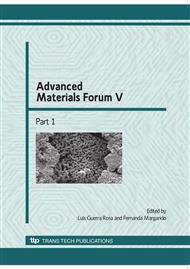p.1030
p.1036
p.1042
p.1047
p.1053
p.1059
p.1065
p.1073
p.1079
The Influence of Sodium Molybdate on the Properties of Zn-Ni Layers Obtained by Electrolytic Deposition
Abstract:
This study was undertaken in the aim to try the limit of extraction of Zn from Zn-Ni system. The aim was realized by the addition of MoO42- ions into the galvanic bath containing Ni2+ and Zn2+ ions. Zn-Ni-Mo layers were deposited under galvanostatic conditions on (OH18N9) austenitic steel substrate. The influence of Na2MoO4 concentration in a bath on the surface morphology, chemical and phase composition and the corrosion resistance of obtained layers, was investigated. The properties of Zn-Ni-Mo layers were compared to the properties of electrolytic Zn-Ni layer. Structural investigations were performed by the X-ray diffraction (XRD) method. The surface morphology and chemical composition and surface chemical elements distribution of deposited layers were studied using a scanning electron microscope. Electrochemical corrosion resistance investigations were done by classical Stern method and electrochemical impedance spectroscopy. The potentiodynamic curves in the range of 0.05V to the potential of open circuit, were obtained. On the base of these curves the parameters like corrosion potential- Ecor, corrosion current density- icor and the polarization resistance- Rp were determined. These values served as a measure of the corrosion resistance of obtained layers. Results of impedance investigations were presented on the Nyquist Z”= f (Z’) and the Bode log Z = f (log) and = f (log), diagrams. On the basis on this research, it was exhibited that surface morphology, chemical composition of Zn-Ni-Mo layers are dependent on Mo contents. The optimal content of Na2MoO4 in the bath for the sake of corrosion resistance in 5% NaCl, is found to be 1.2 gdm-3.
Info:
Periodical:
Pages:
1053-1058
Citation:
Online since:
January 2010
Authors:
Price:
Сopyright:
© 2010 Trans Tech Publications Ltd. All Rights Reserved
Share:
Citation:


